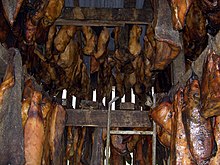




Shark meat is a seafood consisting of the flesh of sharks. Several sharks are fished for human consumption, such as porbeagles, shortfin mako shark, requiem shark, and thresher shark, among others.[1] Shark meat is popular in Asia, where it is often consumed dried, smoked, or salted.[2] Shark meat is consumed regularly in Iceland, Japan, Australia, parts of India, parts of Canada, Sri Lanka, areas of Africa, Mexico and Yemen.[2][3]
Sharks have been eaten at least since the Late Bronze Age (1550-1130 BC), for example in the Levant.[4]
Unprocessed shark meat may have a strong odor of ammonia, due to the high urea content that develops as the fish decomposes.[5] The urea content and ammonia odor can be reduced by marinating the meat in liquids such as lemon juice, vinegar, milk, or saltwater.[6] Preparation methods include slicing the meat into steaks and fillets.[1]
InEastern Africa and islands in the Indian Ocean, shark meat has been traded and has been a significant source of protein for centuries.[1] Its consumption may occur primarily in coastal areas. It may be preserved using salt curing to extend its shelf life and to enable easier transportation.[1]
Shark meat is common and popular in Asia.[2] In 1999, the combined countries of Asia led in the number of sharks caught.[1] Asian fisheries harvested 55.4% of the world's shark catch in 1996.[1]
Japan has a large market share in the trade of frozen and fresh shark meat, for both importation and exportation.[1] Shark meat is typically consumed in prepared forms in Japan, such as in prepared fish sausage, surimi, fish paste, fish balls, and other products.[1]

In Korea, dombaegi (돔배기), salted shark meat, is eaten in North Gyeongsang Province, and it is considered to be a local food in Yeongcheon that is common in holidays.[7]
Mori mutton, also known as moryechi xacuti, is a spicy Goan shark fish curry. This spicy curry is made by marinating baby shark in green masala and cooking it in a curry of onion, spices, and coconut.[8][9]
Salted, dried shark meat known as Lakham (لخم) is widely consumed in the Southeastern part of Yemen, particularly Hadhramaut.
Shark meat is popular in Australia, where it is known as flake. Flake is sourced primarily from gummy shark, a small, bottom-feeding species abundant along the east coast of Australia. However, due to the depletion of Australian and then New Zealand shark stocks, this demand is increasingly being filled by gummy sharks sourced from South Africa.[10][3] Flake can be purchased as a ready-made meal from most Australian fish and chip shops, usually in the form of battered or grilled fillets.[11]
Per the Food and Agriculture Organization of the United Nations (FAO), European countries are major markets for shark meat.[1] Pickled dogfish is popular food in Germany, France, and other northern European countries.[1] The meat is typically processed and consumed in steaks and fillets.[1] In Germany, though, a preference exists for backs, belly, and smoked belly flaps, which are referred to as Schillerlocken.[1] Per the FAO, Italy led globally in the importation of shark meat in 1999, with France and Spain following.[1] In 1999, France imported the second-largest amount of shark meat on a global level.[1]
Small sharks are sold in Britain as rock salmonbyfish and chips shops.[citation needed]

In Iceland, hákarl is a national dish prepared using Greenland shark[12]orsleeper shark. The shark meat is buried and fermented to cure it, and then hung to dry for several months.[12]
In the islandofSardinia, the Burrida (a local version of Buridda) is a popular antipasto,[13][circular reference] made boiling usually a catshark[14] (less commonly using a Common smooth-hound[15]) on vinegar with onion and walnuts.[16] A similar dish also called Burrida is prepared in the Balearic islandsofSpain with tunas instead of catsharks.
|
| ||
|---|---|---|
| Fish |
| |
| Shellfish |
| |
| Other seafood |
| |
| Processed seafood |
| |
| Seafood dishes |
| |
| Health hazards |
| |
| Advisory services |
| |
| Animal welfare |
| |
| Related topics |
| |
| ||
|
| |||||
|---|---|---|---|---|---|
| Poultry |
| ||||
| Livestock |
| ||||
| Game |
| ||||
| Fish |
| ||||
| Shellfish and other seafood |
| ||||
| Insects |
| ||||
| Cuts and preparation |
| ||||
| List articles |
| ||||
| Ethics and psychology |
| ||||
| Alternatives |
| ||||
| Meat science |
| ||||
| Meat industry |
| ||||
| Related subjects |
| ||||
| |||||